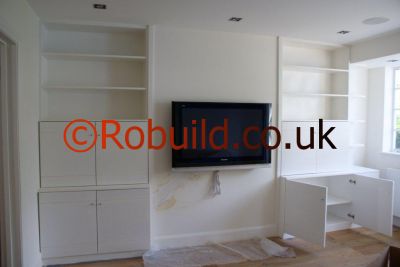It is worth taking extra trouble when you have an alcove with a window. Many people simply curtain off the whole area by running a rail or rod across the front of the alcove, thus cutting it off from the rest of the room at night. This is a waste of both space and decorative potential. Curtain tracks are available which can be bent by hand around the insides of the alcove so that the curtains can be pulled back around the walls by day.

Alternatively, you could fit a simple roller blind which would not cut the alcove off from the rest of the room when pulled down at night. Alcoves are especially good for creating decorative effects a little out of the ordinary. You could decorate the alcove in a different wallcovering from the rest of the room—perhaps using something special such as paperbacked silk, grasscloth or metallic paper. This could then be used as a backdrop for shelving and to enhance any decorative objects on display. A less expensive—but equally effective— method is to paint the alcove walls a tone or two deeper than the colour chosen for the rest of the room.
Mirrors, too, can be used to enhance an alcove, and they will give a feeling of extra space in the rest of the room. You can buy the mirror in a large piece and fix it to the wall with mirror-screws with domed chrome heads; or you could cover the wall with mirror tiles, fixed with self- adhesive pads. Bronzed mirrors are more sophisticated, and perhaps less disturbing for people in the room as their reflections are dimmed. In all these arrangements, whether with shelves or mirrors, a grander, ‘period’ effect can be created by building arches over the tops of the alcoves adding plaster mouldings if desired. Painting and Decorating the alcove should be done in theme with the decor.
Where two alcoves flank a chimney breast, remember that there is no need for each to be treated in the same way. In fact it often looks better if the shelf arrangements do not exactly match, although they should balance each other. If the fireplace has been removed, it is possible to treat one alcove and the chimney breast as a unit, leaving the other alcove mostly empty. You can build deep shelves projecting from one alcove and continue shallower shelves across the face of the chimney breast, with perhaps one deep shelf at seating height across the remaining alcove. Now that you have taken the trouble to give your alcoves a special decorative treatment, make sure that the possessions you put on display do your ideas justice.
An alcove is the perfect place to show off a treasured collection of old glass, silver, or a particular colour or make of china, or carved ivory animals, painted eggs or wooden boxes. Consider using glass or mirrored shelves for added glamour. Or use an alcove for a stunning display of leafy plants, or vases of fresh or dried flowers, When setting up alcove displays, pay particular attention to lighting. Slim, fluorescent strips can be used to provide lighting at the front or back of alcove shelving and the lamp can be concealed with a narrow strip of wood. If a gap is left between the back of the shelves and the walls, lighting can be used very effectively to flood the back of the wall.
You can also light an alcove from the front, using a spotlight trained on the objects you wish to highlight. Finally, a word of warning. If you do not want to fill in an alcove with built-in storage spaces or shelving, but prefer to use it to set off an interesting piece of furniture, be sure to take the alcove measurements with you when you go hunting around furniture or junk shops. Remember that alcoves on either side of a fireplace are not necessarily exactly the same size, particularly in old houses. Measure the alcove at the skirting board, and again further up the wall. And, when shopping, beware of furniture which may have a projecting piece around the top which might prevent it from fitting into an alcove: always measure furniture at its widest point.
